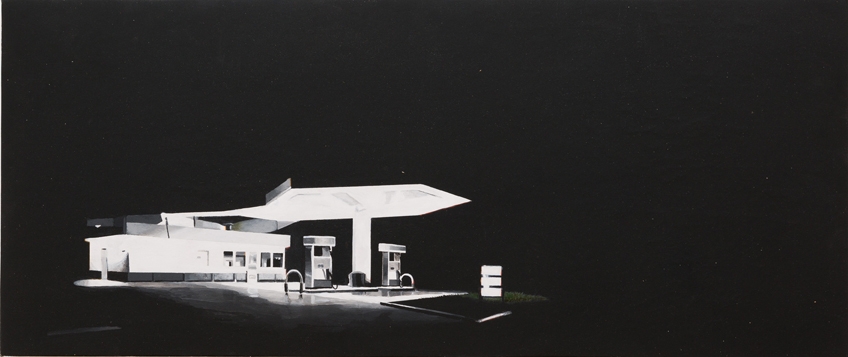Los Angeles artist Robert Olsen passed away in his sleep from a heart condition at the age of forty-four in April 2014, leaving behind a body of work that was a testament to discipline and simple diligence. Olsen would draw the same object for weeks, if not months, posting his drawings on a blog and then working the drawings slowly into oils. Popular subjects included oranges, Moleskine notebooks, cinderblocks, bus stops and glowing commercial signs. Most of his paintings concerned Los Angeles at night, close studies of bright highlights against pitch-black backgrounds.
Olsen’s images are sharp and isolated, sometimes thrown into the harsh glare of a spotlight or apparently, at times, glowing from within. The direction and source of light was an obsession for Olsen, and he felt that he could best study light in its absence on empty streets. Many considered Olsen LA’s resident Edward Hopper, a man who showed us the underside of urban living, the shadows of industry at the end of day. Olsen’s images are always plainspoken but incredibly tense. The tension in waiting for a traffic light to turn from red to green could, in Olsen’s world, pivot quickly to a metaphor for free-floating and unmoored anxiety.
A 20 X 48 cm oil from 2009, Lemon Within a Very Long Rind, has the type of brilliant finish and deep shadow that mark the still lifes of Zurbarán and other Spaniards, a tradition often intent on virtuosity and showy articulation that can dazzle with detail. Olsen plays to this level of artistry, but his lemon painting is not simply a display of artistic mastery; it is a meditation on the fleeting nature of such perfections. A second later, it seems, the fruit will be in decline, but in the painting it is held in the grace of its present moment. There is something about that long, twisting rind, the dance from glow to dark across its surface, that makes this painting, like the legacy of memento mori on which it draws, a testament to the false dream of immortality.
There can be false notes in Olsen’s work – as when he lifted the veil of LA, perhaps more than he should have, in Weegee-type scenes of crimes or S&M . Olsen was too curious, too in awe of the contours and subtleties of darkness, to need this sort of overt, active lonely content. Instead, he was most at home with the poetry one can find in the leftovers of parties or the enigmas of capitalism when its cash registers are closed for the night.
In the feverish landscape of contemporary art, Olsen could hide in plain sight, mounting a show each year, and never receiving much acclaim. In an artworld that measures value by the metre, his paintings were contained within a matter of centimetres and needed no more to make an impact. It is a pity Olsen is not better known. At their modest, reserved best, Olsen’s paintings connect to the deepest strains of history, while staying relevant to how we live right now.
This article was first published in the March 2015 issue.
